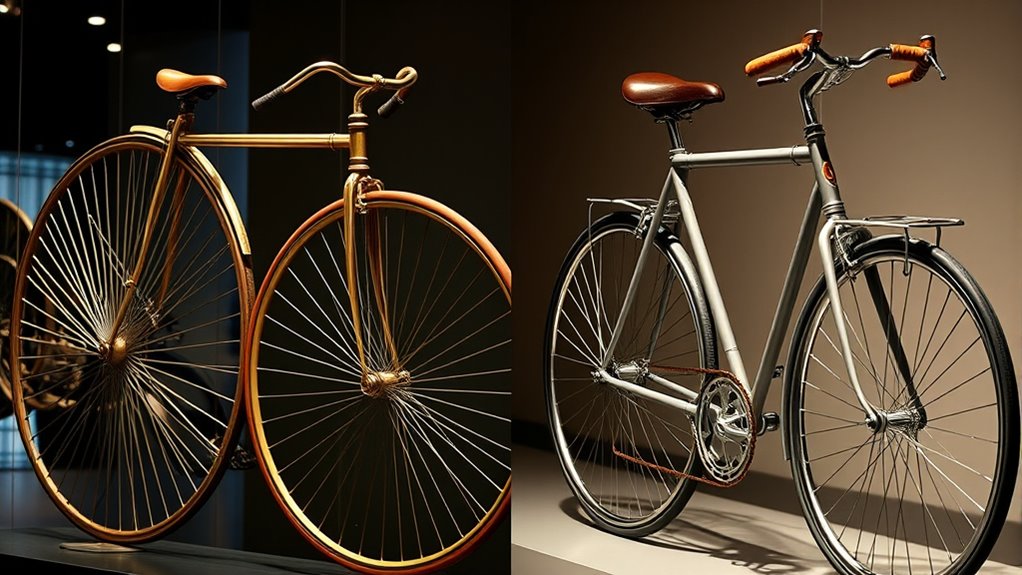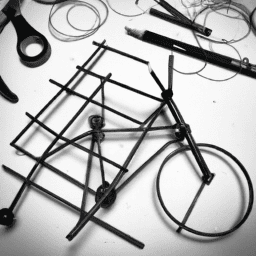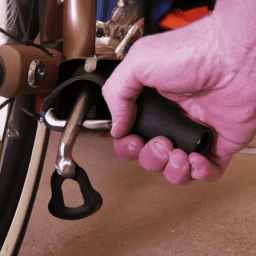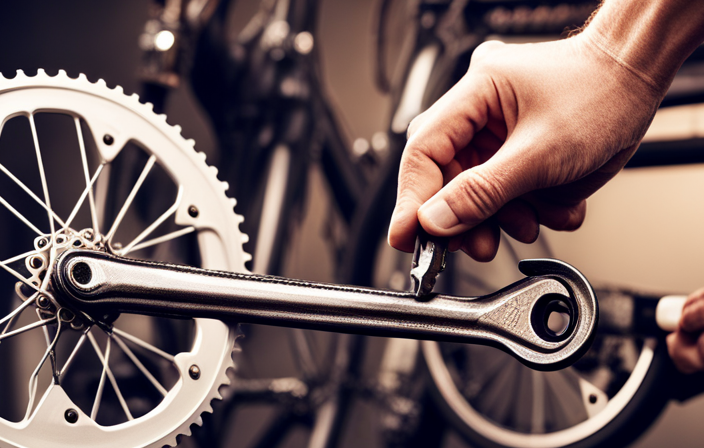The evolution of bicycle design takes you from the rough boneshakers to the high-wheeled penny-farthings, which were hard to mount and dangerous. You then see the breakthrough with safety bikes in 1885, making cycling safer and more accessible, especially for women. Later innovations brought lightweight materials, specialized styles, and electronic features. Today, electric and smart bikes combine technology and design. Continue exploring to discover how these advancements shape the future of cycling.
Key Takeaways
- Early bicycles like boneshakers and Penny Farthings featured high wheels, leading to safety challenges and limited usability.
- The advent of safety bicycles in 1885 introduced chain drives and equal-sized wheels, enhancing stability and safety.
- Innovations in materials and ergonomic design diversified bicycles, including mountain, fat, gravel, and folding bikes for various terrains.
- Modern bicycles incorporate advanced materials, electronic shifting, and smart features like sensors, GPS, and integrated lighting.
- Future trends focus on lightweight composites, energy-efficient motors, and self-charging systems to improve performance and sustainability.
The Early Days of Cycling: Boneshakers and Penny Farthings

In the early days of cycling, bicycles like boneshakers and Penny Farthings revolutionized transportation, though they came with significant challenges. Boneshakers, also called velocipedes, appeared in the 1860s, made of wood with metal parts, providing a rough ride on cobblestone streets. By the 1870s, Penny Farthings gained popularity, featuring a high wheel often over 50 inches in diameter, which allowed you to reach higher speeds. The large front wheel, or high wheel, was key to speed but made mounting and dismounting difficult and dangerous. Riders faced frequent accidents, including “headers,” where they flew over the handlebars. Despite their limitations, these early designs pushed cycling forward, setting the stage for safer, more practical bicycles.
The Breakthrough of the Safety Bicycle and Its Impact

The introduction of the safety bicycle in 1885 revolutionized cycling by offering a more stable and safer design than the high-wheeled Penny Farthing. Its two equal-sized wheels and chain drive provided better balance and control, making riding less risky. The diamond-shaped frame and rear-wheel drive allowed for easier mounting and improved weight distribution, reducing the chance of accidents. This innovation made cycling accessible to many, including women, thanks to its comfort and safety. As a result, the safety bicycle quickly replaced the dangerous high wheel models and became the standard in bicycle engineering. Its impact extended beyond safety, enabling mass production and transforming bicycles into practical, everyday transportation, setting the stage for future innovations. The development of modern materials further enhanced bicycle durability and performance. Additionally, advancements in bicycle ergonomics contributed to increased rider comfort and efficiency. Moreover, the technological innovations in manufacturing processes allowed for greater affordability and widespread adoption of bicycles worldwide. Furthermore, the design principles established by the safety bicycle laid the foundation for the development of modern bicycle engineering, influencing contemporary bicycle styles and features. Incorporating safety standards in manufacturing has also helped improve overall bicycle safety and rider confidence.
Innovations and Diversification in the 20th Century
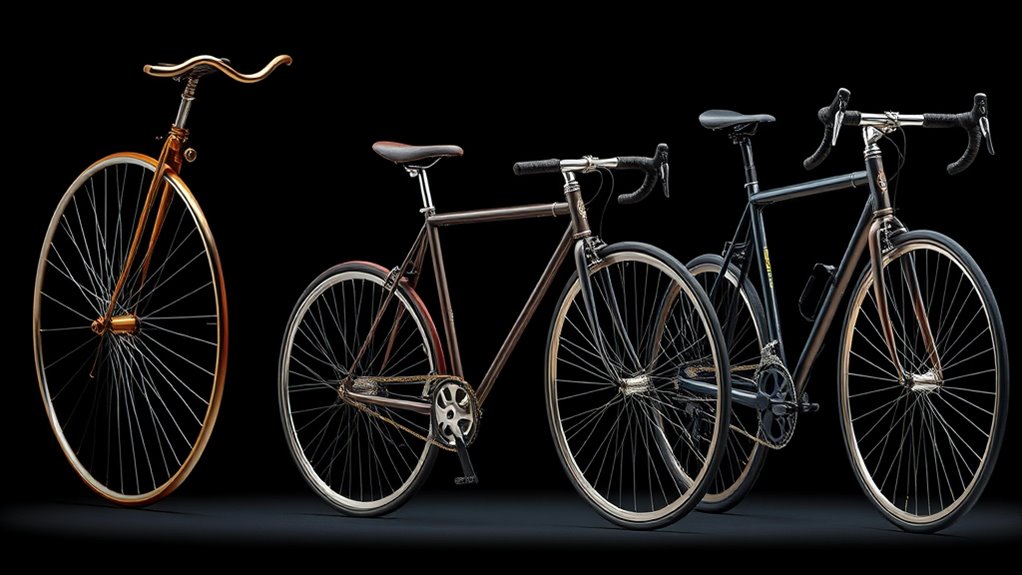
Throughout the 20th century, bicycle design saw a surge of innovations that enhanced performance and expanded its versatility. You benefited from lightweight frames made of steel and aluminum, which boosted speed and maneuverability. Geared bikes, with over 30 speeds, allowed you to tackle different terrains more efficiently, making cycling more adaptable. The rise of mountain bikes in the 1970s introduced durable frames, wide tires, and suspension systems for off-road adventures. In the 1980s, BMX bikes became popular, featuring compact frames and thick tires for stunt riding and dirt racing. High-tech materials like carbon fiber, along with disc brakes and indexed shifting, further diversified bicycle types to suit specific riding styles and conditions, transforming cycling into a more specialized and dynamic activity. Additionally, advancements in modern bicycle technology have incorporated features such as improved aerodynamics and enhanced brake systems, making bikes safer and more efficient than ever before. These innovations also include smart features like electronic shifting and integrated lighting, which continue to evolve the cycling experience. Moreover, ergonomic design improvements now focus on rider comfort and injury prevention, contributing to healthier and more enjoyable riding experiences.
Technological Advancements Shaping Modern Bicycles

Modern bicycles use advanced materials like carbon fiber and lightweight alloys to stay strong while shedding weight. You’ll find bikes with over 30 gears, making it easier to handle different terrains, thanks to innovations like indexed shifting and disc brakes. Electric motors and smart tech, such as GPS and performance trackers, also boost convenience and safety on your rides. Additionally, Kia Tuning techniques have inspired innovative approaches to optimizing vehicle performance, paralleling the advancements seen in modern bicycle technology. Moreover, the integration of Volkswagen Tuning concepts into bicycle design has led to the development of high-performance e-bikes with enhanced power delivery and efficiency. Innovative vehicle tuning techniques continue to influence the evolution of bicycle design, creating more efficient and customizable riding experiences. Advances in Self Watering Plant Pots have shown how thoughtful design can improve usability and plant health, which parallels the focus on user-centered innovations in bicycle engineering.
Lightweight Material Innovations
Have you noticed how lightweight materials have transformed bicycle design? Modern bikes now use aluminum alloys, carbon fiber, and titanium to cut weight and boost performance. Carbon fiber frames, with their high strength-to-weight ratio, are popular in racing bikes, making them faster and more maneuverable. Advances in material technology have led to durable, lightweight components like rims, handlebars, and seat posts, improving overall efficiency. This shift from steel to composite materials has made bikes quicker, more responsive, and easier to handle on different terrains. The table below highlights some key materials shaping today’s bicycles:
| Material | Benefits | Common Use |
|---|---|---|
| Carbon fiber | High strength, lightweight | Racing frames, components |
| Aluminum | Lightweight, corrosion-resistant | General bikes, parts |
| Titanium | Strong, durable, lightweight | High-end touring bikes |
| Advanced alloys | Enhanced strength-to-weight ratio | Structural components |
Additionally, innovations in material technology continue to push the boundaries of bicycle performance and design.
Advanced Gear Systems
Advanced gear systems have revolutionized how cyclists manage different terrains and riding conditions. With multi-speed setups, you can easily switch gears to optimize pedaling efficiency whether climbing hills or riding on flat surfaces. Modern gear shifting uses derailleur mechanisms or internal hub gears for smooth, precise changes with minimal effort. Indexed shifting technology ensures your gears align accurately, reducing mis-shifts or chain slips, so your ride remains seamless. Over 30 gears are now common, giving you versatile options for any terrain. Innovations like electronic gear shifting and semi-automatic systems further improve reliability and ease of use. These advancements make gear changes quick and effortless, allowing you to focus on enjoying your ride without worrying about manual adjustments or gear misalignment. Advanced gear systems also benefit from lightweight construction, which enhances overall bike performance and handling.
Electronic and Smart Features
Building on the improvements in gear systems, the integration of electronic and smart features has transformed how bicycles operate and interact with riders. Smart bikes now include connected sensors that collect real-time data on performance, location, and health metrics, syncing seamlessly with smartphones. Electronic shifting, such as Shimano Di2 or SRAM eTap, allows precise, automatic gear changes, boosting efficiency. Electric bikes (e-bikes) use rechargeable batteries and motor assistance, making cycling accessible to more people. Innovative features like integrated lighting, anti-theft alarms, and app diagnostics emphasize the trend toward smarter bikes. Additionally, the use of advanced tuning in bike components ensures optimized performance and longevity. The incorporation of sensor technology enhances safety and personalization for riders. Moreover, the increasing adoption of comprehensive insurance options helps protect valuable bikes from unexpected damages or theft.
The Development of Specialized Bicycle Types

How did different terrains and riding needs shape the development of specialized bicycles? You can see it in the variety of bikes designed for specific conditions. For example:
- Mountain bikes, introduced in the 1970s, feature wide tires, tough frames, and suspension to conquer rough off-road trails.
- Fat bikes have oversized tires that offer stability and traction on soft surfaces like snow, sand, and mud.
- Gravel bikes blend features of road and mountain bikes, with wider tires and relaxed geometry for mixed terrains and long-distance rides.
- Folding bikes cater to urban commuters, with collapsible frames for easy storage in small spaces.
- The development of specialized bicycle types reflects advancements in materials and design to meet diverse riding demands and enhance performance across different environments. Additionally, innovations in ergonomic design and skincare patches such as improved adhesives and materials have influenced the ergonomic design of certain bicycles, ensuring comfort during extended rides.
- Modern bicycle development also incorporates advanced materials, like carbon fiber and lightweight alloys, to improve efficiency and durability for various riding conditions.
The Rise of Electric and Smart Bikes
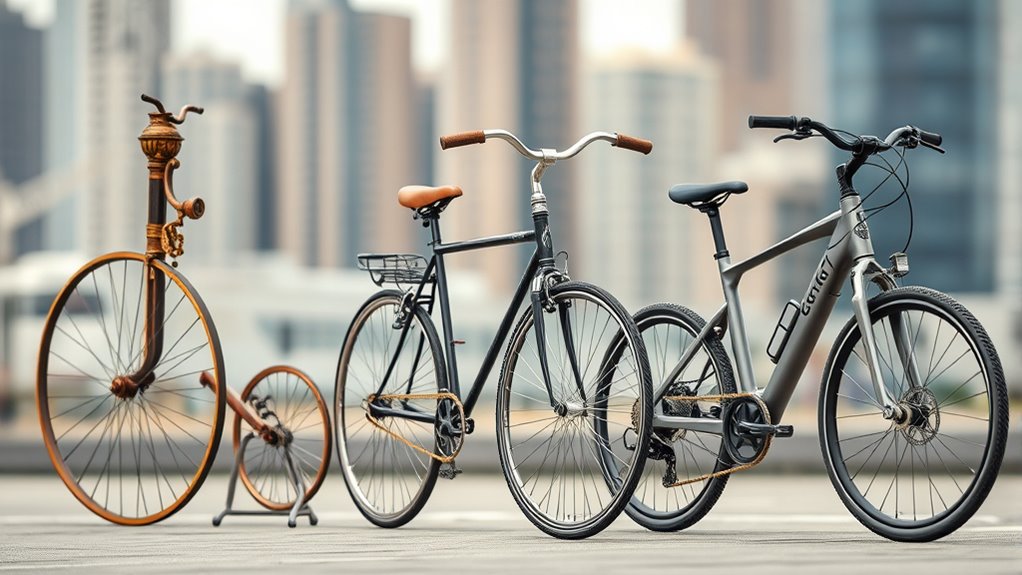
Electric and smart bikes have transformed cycling by making rides easier, faster, and more connected. You can now enjoy pedal assistance that reduces effort and smart features that track your performance and routes in real time. These innovations are changing how people commute, exercise, and explore on two wheels.
Electric Power Boosts
Have you noticed how electric bikes have transformed cycling in recent years? These bikes use integrated motors powered by rechargeable batteries, providing pedal assist that makes riding easier. This technology has opened up cycling to more people, whether for commuting or recreation. Here are four key points:
- Electric bikes leverage pedal assist sensors to detect your pedaling effort and adjust motor support accordingly.
- Integrated motors are seamlessly built into the frame, offering smooth, efficient power without extra bulk.
- Since their debut in the early 2000s, e-bikes have become increasingly popular, with global sales soaring.
- Modern e-bikes often feature multiple power levels, enhancing control and customization for riders.
This power boost continues to shape the future of cycling, making it more accessible and eco-friendly.
Smart Technology Integration
Ever wondered how bikes are becoming smarter and more connected? Modern smart bikes leverage IoT, sensors, and onboard computers to enhance your ride. They feature GPS navigation, performance tracking, and automatic gear shifting, all accessible via your smartphone. Sensors monitor metrics like speed, cadence, and heart rate in real time, giving you detailed insights. IoT integration enables remote diagnostics, theft tracking, and personalized profiles, making your cycling experience seamless. Imagine a bike with the following features:
| Feature | Function | Benefits |
|---|---|---|
| GPS Navigation | Guides routes and tracks | Efficient travel, avoid getting lost |
| Heart Rate Sensors | Monitors your health | Optimized training |
| Connectivity | Syncs with smartphone | Easy data access and control |
| Automatic Gear | Shifts gears based on conditions | Smooth and efficient riding |
| Remote Diagnostics | Checks bike status remotely | Reduced maintenance surprises |
Smart bikes are transforming how you ride, making cycling smarter and more connected.
Enhanced Riding Experience
Smart technology has already transformed cycling by making bikes more connected and user-friendly. Electric and smart bikes enhance your riding experience through features like motors that help you pedal effortlessly, letting you reach higher speeds without extra effort. With lightweight materials such as carbon fiber, these bikes are easier to handle and more durable. The design often includes sleek wheels and a diamond frame, optimizing comfort and efficiency. Here are four key benefits:
- Increased speed and reduced fatigue with motor assistance
- Better control via integrated GPS and automatic gear shifting
- Extended range thanks to advanced batteries and lightweight construction
- Enhanced safety and accessibility for riders of all fitness levels
These innovations make conquering challenging terrains and long distances more enjoyable, elevating your ride to the next level.
Future Trends in Bicycle Design and Technology

The future of bicycle design and technology is set to be revolutionized by innovative features that enhance performance, sustainability, and user experience. Expect bikes made with lightweight materials like carbon fiber and composites, making them more aerodynamic, durable, and easier to handle. Smart technologies such as GPS, performance tracking, and automatic gear shifting will become standard, helping you ride more efficiently. Electric motors will advance with more efficient batteries, increasing range while reducing weight. Solar panels integrated into bicycles could enable self-charging, extending your riding distance. Additionally, energy harvesting systems like regenerative braking will boost sustainability. These developments will create bikes that are smarter, lighter, and more eco-friendly, transforming your riding experience and pushing the boundaries of modern bicycle design.
Frequently Asked Questions
What Is the Difference Between a Penny-Farthing and a Modern Bicycle?
You’ll notice that a penny-farthing has a huge front wheel and a tiny rear wheel, with you sitting high above the ground. In contrast, modern bikes have two wheels of equal size, positioning you closer to the ground for stability. Modern bikes also include gears, brakes, and a lower seat, making riding safer and more comfortable, unlike the high, risky stance of a penny-farthing.
How Has the Bicycle Changed Over Time?
Imagine you’re riding a bike today and notice how it’s lightweight, fast, and comfortable. Over time, bicycles have transformed from heavy, unsafe models like the Penny Farthing to modern designs with safety features, gears, and lightweight materials. These changes improve your riding experience, whether for commuting, racing, or recreation. Continuous innovations, like electric motors and advanced frames, keep pushing bicycles forward, making each ride smoother and more efficient.
What Came After the Penny-Farthing Bike?
After the penny-farthing, you saw the development of the safety bicycle in 1885. This new design had two equal-sized wheels and a chain drive, making riding safer and more comfortable. It introduced the diamond-shaped frame, improving stability. Over time, innovations like pneumatic tires, gears, and lightweight materials made bikes even better. These changes laid the groundwork for today’s bicycles, including mountain, road, and electric bikes.
What Is the Modern Ancestor of Modern Bikes?
Imagine tracing the roots of your bike through a twisting river of innovation. The modern ancestor of today’s bikes is the safety bicycle, introduced in 1885 by John Kemp Starley. With its equal-sized wheels, chain drive, and sturdy frame, it’s like the blueprint that shaped every pedal stroke you take. This design revolutionized cycling, providing safety, balance, and control—foundations that still support the diverse bikes you ride today.
What Was Weird About the Penny-Farthing Bicycle?
The Penny-Farthing looks pretty weird compared to today’s bikes. Its huge front wheel, often over 50 inches, makes it stand out, and the tall frame makes mounting and dismounting tricky. You’d also notice its high center of gravity, which makes you prone to falling forward over the handlebars. Plus, it lacked modern brakes, so stopping safely on steep or rough terrain was difficult, making it quite dangerous.
Conclusion
So, now you’re riding a sleek, electric wonder, leaving penny-farthings and boneshakers in the dust. Who knew that a simple two-wheeled machine would evolve into a high-tech marvel, transforming your daily commute into a futuristic joyride? As bikes continue to get smarter and faster, maybe one day you’ll pedal through virtual worlds or zip invisibly past traffic. One thing’s certain—bicycle evolution proves humans just love turning a simple ride into a wild, wheeled adventure.
